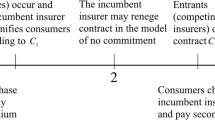Abstract
New models of multi-period insurance show that health insurance buyers can be protected against changes in premiums from health shocks associated with chronic conditions by the addition of “guaranteed renewability” provisions. These models assume that a buyer’s risk level in every time period is observed by all insurers. They also require a premium sequence that is “front-loaded,” which may be costly to buyers if capital markets are imperfect. We relax the common knowledge feature of the model by assuming that a person’s risk in any time period is known only by that individual and the current insurer. One might suspect that a premium sequence with higher later period premiums would be incentive compatible because low risks will have less desirable offerings from alternative insurers. However, we show that generally, only the original premium schedule is incentive compatible, and attempts to alter front-loading will not be an equilibrium.

Similar content being viewed by others
Notes
There is another possible model in which only the insured person, and not even the current insurer, knows when and if the risk changes, but in which insurance is sold as a multi-period contract. We do not develop that model here.
For more details on actions taken by FEMA see http://www.floods.org/ace-files/Levee_Information/map_changes_and_insurance_savings.pdf (accessed 7 June 2011).
Ehrlich and Becker (1972) show that, for a given level of risk aversion and a loading percentage that is independent of the probability of loss, the amount of insurance purchased will not depend on the loss probability.
Assuming that customers have not been overcharged in previous periods. Overcharging in early periods would even increase front-loading and hence capital costs.
This is an assumption we have made, but at the same time a precondition for maintaining the informational advantage of the current insurer if outside insurers can observe premia.
This result is true for uniform premia for high and low risks as assumed thus far. It is always true for low risks. With positive capital costs, high risk premia can deviate in the same way as under complete information, see below.
Withdrawing a GR policy should not be a realistic option, because consumers would not be attractive in the market if buyers had full foresight. But we allow that possibility here since markets may be imperfect and stability is important.
References
Cochrane, J. (1995). Time consistent health insurance. Journal of Political Economy, 103(3), 445–473.
Ehrlich, I., & Becker, G. S. (1972). Market insurance, self-insurance, and self-protection. Journal of Political Economy, 80(4), 623–648.
Frick, K. (1998). Consumer capital market constraints and guaranteed renewable insurance. Journal of Risk and Uncertainty, 16(3), 271–278.
Kunreuther, H., & Pauly, M. V. (1985). Market equilibrium with private knowledge: An insurance example. Journal of Public Economics, 26(3), 269–288.
Miyazaki, H. (1977). The rat race and internal labor markets. Bell Journal of Economics, 8(2), 394–418.
Pauly, M. V. (2006). Time, risk, precommitment and adverse selection in competitive insurance markets. In P.-A. Chiappori & C. Gollier (Eds.), Competitive failures in insurance markets (pp. 11–31). Cambridge: MIT.
Pauly, M. V., & Kunreuther, H. (1983). Equilibrium in insurance markets with experience rating. In J. Finsinger (Ed.), Economic analysis of regulated markets (pp. 91–110). London: Macmillan.
Pauly, M. V., Kunreuther, H., & Hirth, R. A. (1995). Guaranteed renewability in insurance. Journal of Risk and Uncertainty, 10(2), 143–156.
Rothschild, M., & Stiglitz, J. E. (1976). Equilibrium in competitive insurance markets: An essay on the economics of imperfect information. Quarterly Journal of Economics, 90(4), 630–649.
Wilson, C. (1977). A model of insurance markets with incomplete information. Journal of Economic Theory, 16(2), 167–207.
Author information
Authors and Affiliations
Corresponding author
Rights and permissions
About this article
Cite this article
Pauly, M.V., Menzel, K., Kunreuther, H. et al. Guaranteed renewability uniquely prevents adverse selection in individual health insurance. J Risk Uncertain 43, 127–139 (2011). https://doi.org/10.1007/s11166-011-9124-2
Published:
Issue Date:
DOI: https://doi.org/10.1007/s11166-011-9124-2



